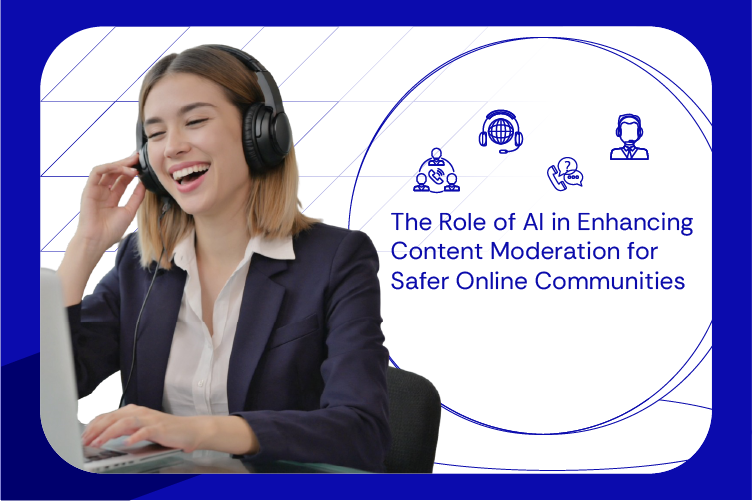To enhance content moderation quality most businesses nowadays are using AI-driven moderation systems. Using AI models, you can automate the process of reviewing and managing user-generated content. These tools automatically detect, filter, and block harmful, explicit or misleading material such as hate speech, explicit images, or spam.
If the internet is the Wild West, content moderation is your sheriff. To grow your consumer brand or D2C business organically, you must let your users post:
- Reviews
- Comments
- Media (images and videos)
But, do you know it also opens the door to spam, hate speech, and harmful content? You can’t afford to monitor every word or image yourself. And, hiring a full-time team may be out of reach!
Is there a solution? That’s where AI-powered content moderation comes in. In this AI era, most companies prefer AI content moderation. It uses smart software to scan, detect, and block posts that break your rules. Studies show that over 75% of large social platforms now rely on AI moderation tools. That’s largely because organisations utilising AI content moderation report a 30% increase in user satisfaction.
For CX and support leaders in the US, UK & Australia, AI moderation isn’t just a technical tool, it’s a safeguard for brand reputation, compliance and customer trust. This article explores what content moderation is, how AI enhances it and how to deploy it effectively within your business.
What is Content Moderation?

Content moderation is the process of checking and controlling what users post on a website or app. Such checking is performed to ensure the user-generated content follows the rules. It keeps the platform safe and appropriate for other users.
Before the AI era, companies hired “human moderators”:
- They used to look at every post before it appeared online.
- These moderators would decide if the post followed the rules.
- If it did, they approved it; otherwise, they blocked it.
However, such an approach had problems:
- It was slow because the human moderator had to check every post one by one.
- Users often didn’t know why their post was blocked.
- Decisions were sometimes unfair or inconsistent because they depended on one person’s opinion.
This human-only approach was slow, costly and prone to errors. That’s why leading brands now combine AI systems with human oversight, creating a faster and fairer moderation model.
The AI Help to Enhance Content Moderation
To resolve these shortcomings, companies started using a combination of software/ AI tools and human review. It significantly enhanced content moderation. AI tools use machine learning, NLP (Natural Language Processing), and computer vision to detect patterns in text, images, and videos that indicate potentially harmful content.
Let’s see how:
- The AI model scans content for violations (e.g., hate speech, nudity, violence).
- It automatically blocks or flags questionable material.
- A human reviewer evaluates edge cases where AI is uncertain.
This kind of setup became successful because an AI tool alone can make mistakes, such as:
- Some harmful posts might get missed
- Safe posts might get blocked.
Through human review, companies can catch those errors. As a business owner, if you allow users to post reviews, comments, or images, you need a content moderation system. Alternatively, you can outsource to leading social media moderation service providers.
(See how Atidiv delivered 80% time savings and 99% accuracy for a global startup through automation + human QA — read case study).
5 Major Types of Content Moderation

Through content moderation, you can:
- Protect your brand
- Follow legal rules
- Maintain trust with your customers
But how does this moderation happen? To enhance content moderation, most businesses use AI models to check what users post on their website or app. This keeps your business safe from offensive or harmful content.
Such a scrutiny can be performed through five different ways:
1. Pre-Moderation
In pre-moderation, the AI software checks a post before anyone can see it. The software scans the content for specific words or phrases that your business considers harmful, such as:
- Threats
- Obscenity
- Blasphemy
- Offensive language
If the post includes those, it is blocked right away. The person who posted it may also get a warning or lose the ability to post again. This method enhances content moderation by preventing harmful content from appearing in the first place. However, it may delay how quickly content is shown because each post must be scanned first.
2. Post-Moderation
In post-moderation, users can post content immediately. It shows up on the website or app right away. After that, AI or a human moderator checks the post. If the post breaks any rules, it is taken down. This model works well for high-volume eCommerce or review-based platforms but requires timely review cycles and eCommerce customer service outsourcing can help manage these review cycles efficiently.
The problem with this method is that harmful content might be visible before it gets reviewed. However, it is faster for users since they do not have to wait for approval. It still requires you to review flagged content regularly to keep the platform safe.
3. Reactive Moderation
In reactive moderation, the people using your platform are responsible for reporting bad content. They act as the moderators. If a user sees something that breaks the rules, they can report it.
Then, AI or a human moderator looks at it and decides what to do. This method lowers the need for paid moderators. However, you must trust your users to report issues. It also means harmful content might stay up longer until someone notices and reports it.
4. Distributed Moderation
This method is similar to reactive moderation, but it adds a voting system. When a post goes up, users can vote on it. If most people vote that the content is good, it stays up and is shown to more users.
In contrast, if many people vote that it breaks the rules, it may be hidden or removed. This method puts more control in the hands of your user community. It enhances content moderation best when your platform has enough active users who are willing to vote or report content.
5. User-Only Moderation
In user-only moderation, only certain users (such as those who are registered and approved) can report bad content. When several of these trusted users report a post, the system automatically blocks it from others.
This method enhances content moderation by giving more power to users you trust, instead of all users. It also reduces the need for full-time staff moderators. However, it depends heavily on having a group of reliable users who follow your business’s content rules. This setup works best for D2C platforms with loyal, engaged customer bases.
How does AI Enhance Content Moderation?

Recent studies found that AI content moderation systems can process and analyse content up to 1,000 times faster than human moderators. Such speed is particularly helpful if your platforms receive a traffic of millions of posts daily!
Additionally,
- AI is about 90% detection accuracy when detecting harmful content
Modern AI systems can correctly identify explicit material (such as nudity or violent images), about 90% of the time. This means most of the harmful content can be caught and blocked before it reaches your audience.
However, it also means that the system may miss some content or block things that are not actually harmful. That’s why many businesses still use a mix of AI and humans to enhance content moderation quality.
- AI reduces the amount of work humans must do
By using AI moderation, the number of posts that need human review can be cut down by as much as 40%. This allows your staff or team members to spend:
- Less time on routine checks
- More time looking at posts that are harder for AI to judge
Generally, this covers borderline content, sarcasm, or anything that needs context to understand. This again reduces the need for hiring a team of full-time moderators.
However, AI isn’t perfect. It can misinterpret context or cultural nuance, which is why the best systems combine machine speed with human judgment to maintain fairness and empathy.
(Discover how Atidiv ensured 95%+ QA scores and $20M in savings through scalable human-AI moderation — view case study).
How Can You Start Using AI to Enhance Content Moderation in Your Business?

Did you know? In 2022, YouTube removed 5.6 million videos for violating guidelines. The company used AI to identify 98% of extremist content.
As a business owner, you can also use AI to moderate user content and protect your brand’s image. Below is a step-by-step guide on how to get started:
Step I: Define Your Needs
Start by deciding what type of content your platform handles. It could be:
- Text (comments, reviews, messages)
- Images or videos (user uploads, product photos)
- Audio (voice messages or recordings)
Next, set clear goals that can help you enhance content moderation. Ask yourself:
- Do you want to block offensive language?
- Do you need to detect violent or adult content in images or videos?
- Are you trying to stop spam or harmful user behavior?
By understanding your real needs, you can better choose the right tools in Step II.
Step II: Choose the Right AI Tools
Pick tools based on your content type:
| Text moderation | Image and video moderation | Audio moderation |
|
|
|
Ideally, you must choose tools that match the kind of content your users post.
Step III: Set Up and Customise the System
Once you choose the tool, perform these two major tasks:
- Connect the tool to your website or platform using its API. This allows real-time scanning of content.
- Train the system using your own moderation dataset. You can upload past examples of harmful content so the AI learns what to block. This improves accuracy on your specific platform and enhances content moderation.
Step IV: Monitor and Adjust the System
After setup, you must track performance. To do so, you can create a dashboard or report that shows:
- How many posts were flagged?
- How many flagged pots were errors?
- How many posts were missed?
Additionally, collect feedback from users and staff. If users report errors or see harmful content, use that feedback to adjust your settings or train the system again.
Step V: Keep Your System Updated
Update the AI tool regularly to enhance content moderation. Please note that language and user behavior change over time. Thus, your system needs updates to keep up. Also, make sure your moderation follows regional data privacy and content laws. This avoids legal issues and maintains trust with your users.
Pass Your Spam Worries to Atidiv! Let us Moderate For You in 2025

Nowadays, most companies use AI to enhance content moderation. AI tools allow you to monitor user-generated content in real time. However, AI moderation combined with expert human review is now the gold standard for consumer and D2C companies across the US, UK & Australia.
Always remember that as a business owner, you can’t afford to overlook harmful content! It risks your:
- Brand reputation
- User trust
- Legal compliance
If you’re looking to outsource, Atidiv is a trusted partner! Our expert team provides Content Moderation as a Service. We follow an AI + Human oversight approach to keep your platform safe and compliant.
Hire us today to enjoy:
- 24/7 protection from harmful or non-compliant content
- Scalable operations for growing brands
- Human empathy + AI precision in every review
Additionally, Atidiv is a customer experience specialist with over 15 years of experience and offers the following services:
- Omnichannel messaging solutions
- Voice customer care
- Social media support
- Live chat service for website
- Inbound and outbound call center services
Let Atidiv protect your brand and improve CX!
FAQs on Content Moderation
1. Do I need content moderation if my website only has a few user posts?
Yes! Even one harmful or offensive post can damage your brand. Through content moderation, you can:
- Protect your reputation
- Keep users safe
- Show you take responsibility for what’s posted on your platform
Please remember that the size of your audience does not matter!
2. Can AI content moderation replace human moderators completely?
No. AI can scan and flag content faster, but it may miss context or make mistakes. For sensitive or complex posts, human review is still important.
A mix of both is the best approach to increase accuracy and enhance content moderation.
3. How does AI moderation handle different languages or slang?
Modern AI tools understand multiple languages. They can even adapt to slang with training. To improve results and enhance content moderation, you can teach the system using your own data, such as:
- Past posts from your users
- Common terms in your community
4. What if AI blocks content that isn’t actually harmful?
This is one of the downsides of using AI-based content moderation. That’s why it’s important to:
- Review flagged posts regularly
- Allow users to appeal decisions
You can also adjust the settings or retrain the system to reduce these errors and enhance content moderation quality. Always include a review and appeal process.

